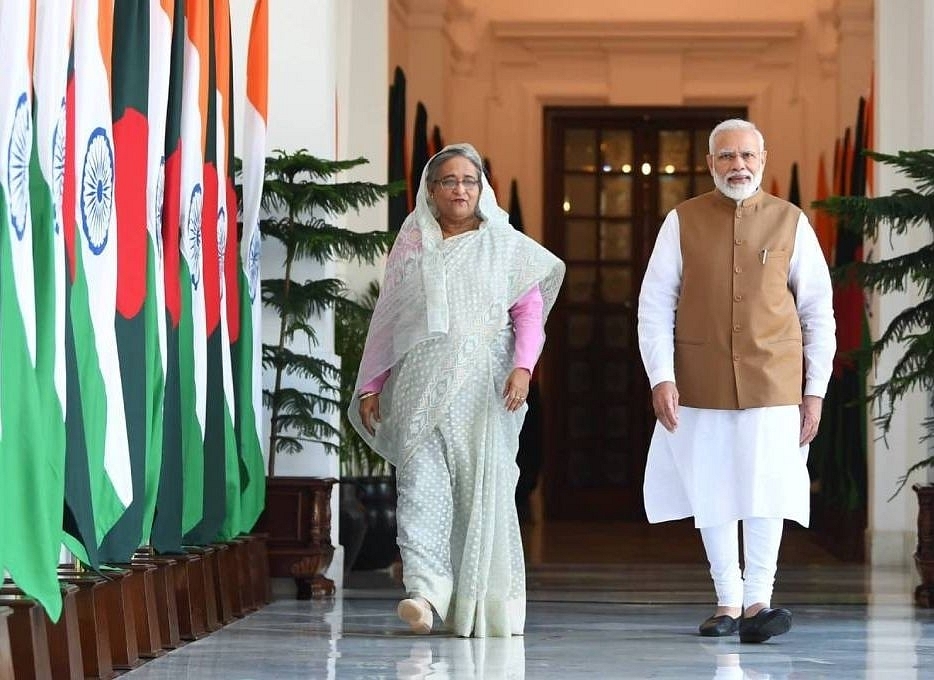Context
India Vs Bangladesh: Media's Comparison Has Serious Fallacies

Prime Minister of India Narendra Modi and Prime Minister of Bangladesh Sheikh Hasina.
Bangladesh's economic success is good news for the subcontinent but commentators need to exercise caution and look at the numbers comprehensively.
Context: Indian media and commentators were going gaga when Bangladesh's per capita income surpassed that of India.
But following the pandemic, the Russia-Ukraine war and inflationary pressures, the economic vulnerabilities of Bangladesh were exposed.
The Government of Bangladesh had to consider approaching the International Monetary Fund (IMF) to bail the country out of an adverse balance-of-payment situation, aggravated by prohibitive global energy costs.
An economic success story: Bangladesh's gross domestic product (GDP) rose from $4 billion in 1960 to $416 billion in 2021.
This is about a hundred times rise over 50 years.
The per capita income is touching $2,500, higher than in India.
Bangladesh has an annual export base nearing $50 billion.
It also has a very healthy 12 per cent exports-to-GDP ratio.
But that's not all.
One trick pony: Bangladesh became an export powerhouse largely as a textile success story.
Its textile exports form almost 70 per cent of the total exports.
The sectoral spread has been very poor despite a two-decade runway of export growth performance.
Even within textiles, Bangladesh exports lower-end, low-margin products with little depth of expertise in more complex areas like technical textiles or textile machinery.
Yet, it has not translated into significant labour force productivity and associated wage curve shift in the nation.
Crutch of GSP: The Generalised System of Preferences (GSP) has greatly supported Bangladesh's exports in European markets.
Members of the General Agreement on Tariff and Trade (GATT) decided to allow for a generalised, non-discriminatory, and non-reciprocal system of tariff preferences to be awarded by some members to others, deviating from the most-favoured nation principle.
The idea was that the richer countries can allow the developing ones to get greater market access through preferential tariffs.
While a member can make adjustments to its programmes, changing recipient countries and product coverage periodically, developed countries keep offering the GSP to the least developed countries or LDCs.
What it means for B'desh: It is because of this system that India has 40% share in American textile imports and has been either the first- or second-biggest supplier for most of the recent years.
However, in the European Union (EU), India only has a 10 per cent market share and ranked a relatively distant fourth to sixth, with Bangladesh, Pakistan, and Turkey consistently staying over India.
It has led to an 8-12 per cent duty benefit for Bangladesh in the EU markets.
For low-end textiles, this is a make-or-break difference as the margin on these products itself may be lesser than the duty advantage with Bangladesh.
But that too is coming to an end.
Preference slated to end: Bangladesh has been marked for graduation out of the LDC status in 2026 by the United Nations.
The country has since been fighting in the WTO to retain its LDC GSP benefits for almost four years.
In the February meeting of the WTO General Council, the Ambassador of Bangladesh pleaded on the LDC graduation proposal:
“There are several unilateral LDC-specific GSP schemes where there are procedures available to extend LDC trade preferences to graduated countries for a certain time-period… It is up to the preference-granting members to see how they want to consider the extension of their unilateral LDC-specific schemes to the same Members for a defined period after graduation… What we are calling for is a best endeavour effort.”
But the US and the EU are not too keen to let graduating LDCs operate with GSP benefits.
Resilience of the Indian economy despite disastrous global shocks shows that even very high economic growth may not by itself be sufficient to thwart exogenous shocks.
The balance-of-payment situation requires macroeconomic management finesse and a large, diversified economy to leverage.
India’s government and the Reserve Bank of India have shown how to use cyclical and countercyclical measures to manage external shocks.
Bottomline: Sovereigns should learn from each other.
But the expectations of learning must be grounded in real data analysis and a well-rounded worldview of relative competitive advantages.
This is the learning from India and Bangladesh’s growth stories.
Support Swarajya's 50 Ground Reports Project & Sponsor A Story
Every general election Swarajya does a 50 ground reports project.
Aimed only at serious readers and those who appreciate the nuances of political undercurrents, the project provides a sense of India's electoral landscape. As you know, these reports are produced after considerable investment of travel, time and effort on the ground.
This time too we've kicked off the project in style and have covered over 30 constituencies already. If you're someone who appreciates such work and have enjoyed our coverage please consider sponsoring a ground report for just Rs 2999 to Rs 19,999 - it goes a long way in helping us produce more quality reportage.
You can also back this project by becoming a subscriber for as little as Rs 999 - so do click on this links and choose a plan that suits you and back us.
Click below to contribute.
Latest